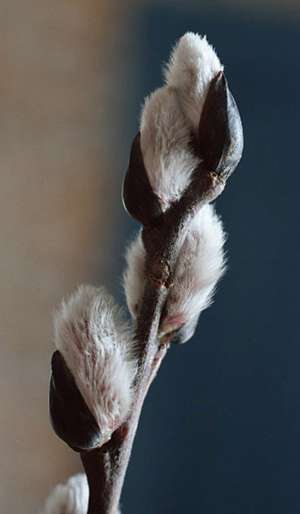

PHOTO COURTESY OF GARRY KESSLER
Silvery pussy willow flowers soon after bursting from of their buds, at this time of year.
March 5, 2005, Page 5
NATURE NOTES
By ANNIE REID
Westborough Community Land Trust
Time for pussy willows
Right on schedule, in spite of snowfalls and frigid temperatures, the end of February has brought us the promise of spring--the first pussy willows.
The furry-looking little silvery flowers of the pussy willow (Salix discolor) begin to burst out of their buds in late winter, often as early as the February school vacation week.
Our native pussy willow grows as a shrub or small tree. It is the first tree to bloom. Many others trees will follow--blooming less conspicuously, except perhaps for their wind-born pollen--in March and April, before their leaves come out in May.
Pussy willow grows in sunny, wet areas, like many other willows. It is sometimes called swamp willow. You'll typically find it on the shores of ponds, along stream banks, and even in wet roadside ditches.
You can see a sizable pussy willow tree about a hundred yards from the entrance to the trail located across the street from the parking lot for the Bowman Street Conservation Area. The Westborough Senior Center also has a nice clump of pussy willow--perhaps a commercial variety--near its parking lot, a site not far from dampness of Cedar Swamp.
As March wears on, the silvery pussy willow blossoms will undergo changes, but they'll never develop petals or petal-like parts. At first, their silvery hairs help to protect the flower parts from cold and harsh weather, much as fur or hair protects an animal. With time and mild weather, the pussy willow blossoms take on a yellowish cast and appear to get larger. They also become easier to spot from a distance.

PHOTO COURTESY OF GARRY KESSLER
A male pussy willow flower with pollen, as it will look in a few weeks.
What's happening? The male and female flower parts are emerging. Like other willows, pussy willow has separate male and female flowers, and they are on separate plants. The male flowers develop thin, pollen-producing stamens and are eventually covered in a bonanza of bright yellow pollen. The female flowers develop thicker, yellow-green carpels, which receive pollen.
These changes take place naturally in the wild, but you can also watch them on pussy willow branches that you cut--or purchase--and put in water in a vase. (To keep the furry gray flowers just as they are, without changing, don't put water in the vase.) If you happen to have branches from both male and female plants, you'll get to see both types of flowers develop.
With pussy willow branches kept in water, kids can have fun playing the role of a bee by transferring a fingerful of yellow pollen from one type of flower to the other. If left in the vase with water, pussy willow branches will often put out roots. You can then plant them if you have a suitable wet spot.
Outside, early bees and other early insects seek out pussy willow flowers and collect their scented nectar, pollinating the female flowers in the process. With little else blooming in early spring, it's not hard for pussy willows to attract hungry bees and insects. The pollen is relatively heavy so it does not contribute greatly to the pollen count or spring hay fever.
Eventually, seed capsules develop on fertilized female flowers. The capsules open when the seeds are ripe. Each tiny seed has a tuft of thread-like hairs that help it float on the wind, so at this final stage the pussy willow gets a fluffy, cotton-like look.

PHOTO COURTESY OF GARRY KESSLER
A female pussy willow flower, as it will look later in March.
When the leaves of pussy willow plants come out, they provide food for the caterpillars of two butterflies that you're apt to see in our area, the mourning cloak (Nymphalis antiopa) and the viceroy (Limenitis archippus or Basilarchia archippus). Other types of willow, as well as other plants, do the same.
The bark of willows, including pussy willows, contains an asprin-like compound. This chemical may serve to discourage insects that might otherwise feed at damaged places on the plant.
Willow bark had a role in Native American and early American folk medicine, although various types of willow contain different amounts of the asprin-like compound. Derivatives of the bark were used on wounds and in combating fever, swelling, and pain.
Varieties of pussy willow are sold commercially for use in gardens and landscaping. Pussy willow is also sometimes planted in conservation projects to prevent erosion along the banks of streams and ponds.